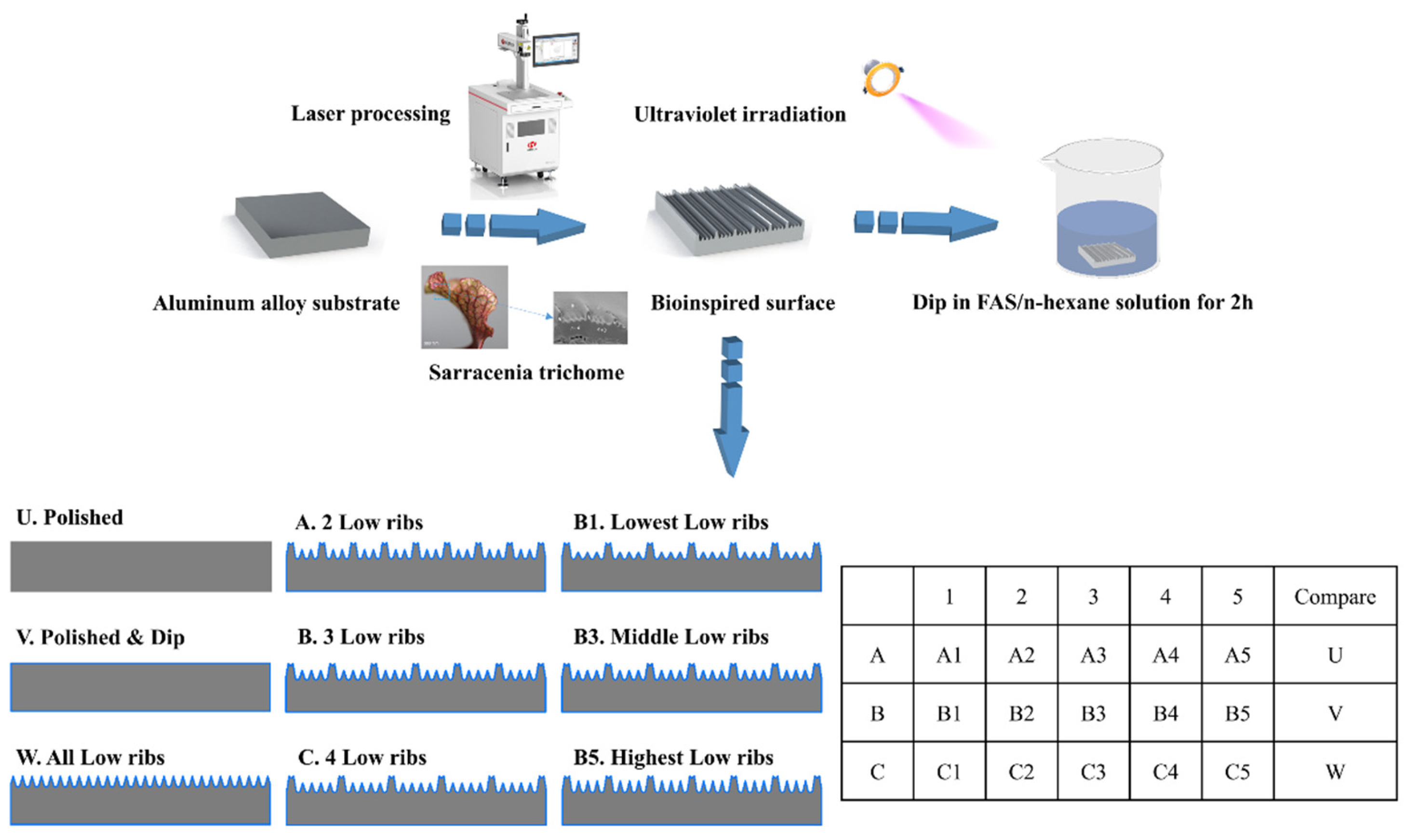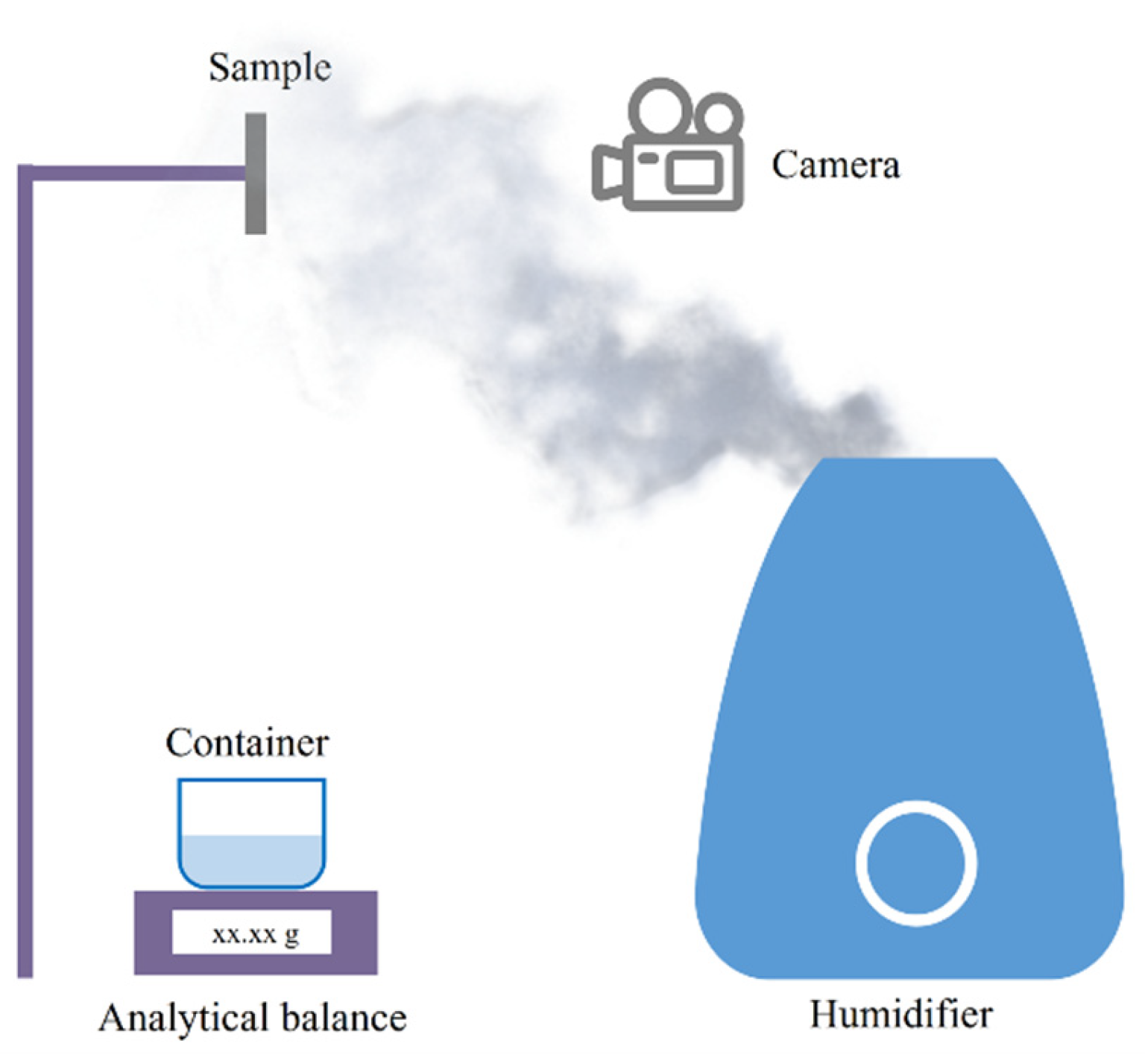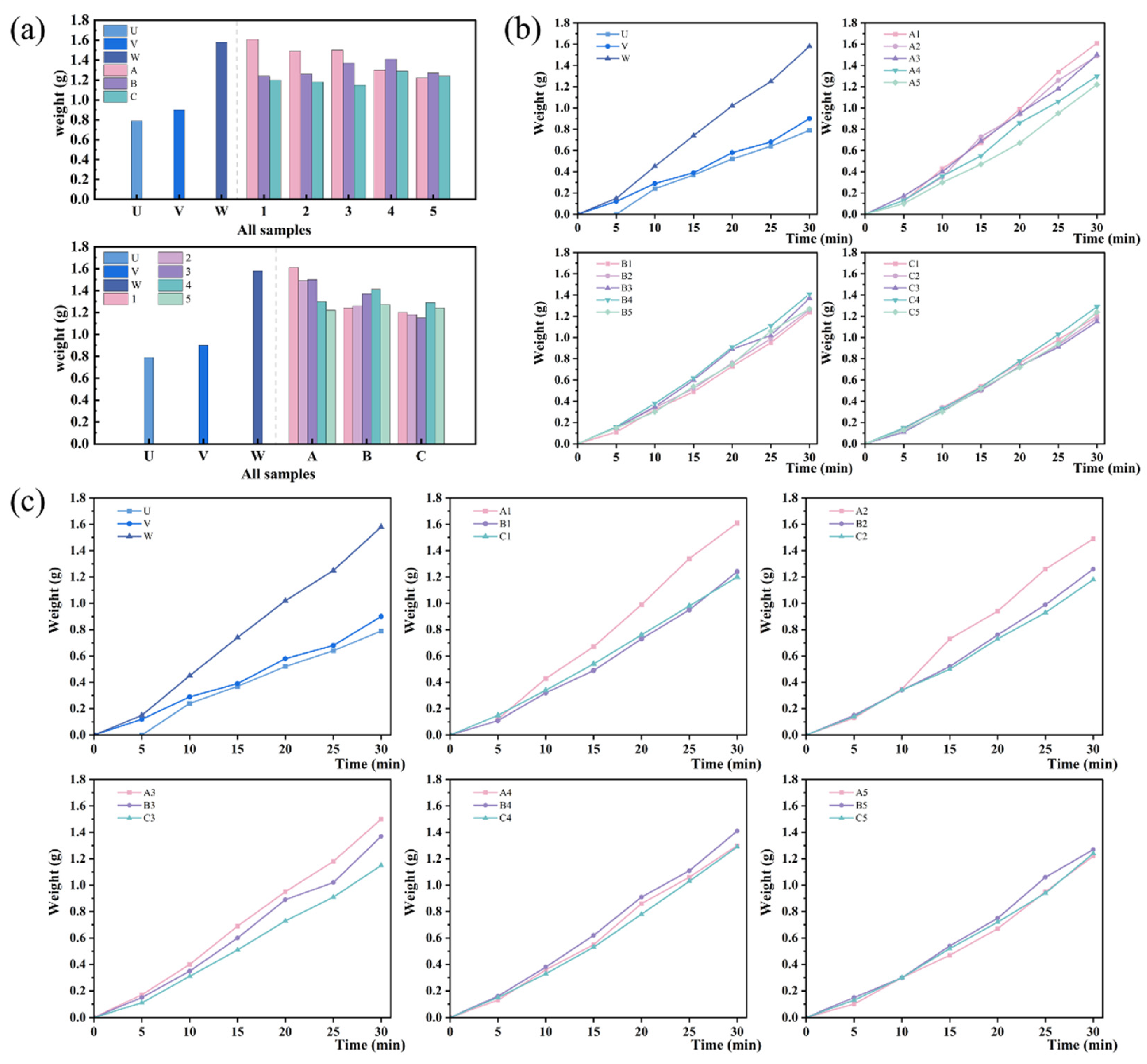3.1. Morphology
The microscopic morphology of the samples is shown in
Figure 2, where
Figure 2a shows the top view of the surfaces of samples with different low rib numbers,
Figure 2b shows the top view of the surfaces of samples with different rib height ratio, and
Figure 2c shows the front view of the surfaces of sample W and sample B1. Both high and low ribs are formed by sputtering on the surface of the laser-processed aluminum alloy. It was found that the height of the ribs is affected by adjusting the spacing of the laser lines in a certain pattern. For example, under the above laser parameters and processing times, the spacing of the lines is lower than 50 µm, which does not result in the formation of a neat and clear rib structure. The spacing of the lines is increased from 50 µm to 70 µm, the ribs width are almost the same, their height are increased gradually, and the height of the ribs formed by sputtering reaches the maximum value when the spacing of the lines is 70 µm. As the line spacing increases from 70 µm to 120 µm, the ribs width gradually increases and the rib height gradually decreases, with the highest level becoming more and more flat. With a line spacing greater than 120 µm, no rib structure can be formed, and only a slight sputtering effect can be observed. As shown in
Figure 2b, the ribs are uniformly distributed, with uniform height and width, and micrometer scale pits and protrusions appear on the surface of the ribs, which are formed by localized melting and vaporization during the sputtering process. Compared with the high ribs, the surface particles and protrusion structures of the low ribs are finer, denser, and have smaller pore sizes than those of the high ribs. UV irradiation was able to promote the hydrolyzing process of FAS in n-hexane and the formation of in situ hydroxylation on the surface to achieve chemisorption. So, dip treatment covers the surface with a dense FAS molecular film, so this is a composite hierarchical microstructure with a more hydrophobic surface.
Figure 3a shows the scanned area of 2 mm × 2 mm extracted from the surface of sample A3 and the 3D morphology view, and
Figure 3b shows the contour curve of the extracted profile in this area. From the figure, it can be seen that the height difference between the high ribs and the low ribs is very obvious, and the surface structure has good integrity. The contour curves show that the shape and size of the high ribs and low ribs are fairly consistent, and the statistics of the structural parameters were carried out by extracting 10 regions of the same sample and 10 profiles from each region. Due to the uneven height of the protrusions at the top of the high ribs, the main structural parameters (High rib height
H, Low rib height
h, and Microchannel width
w) were defined as shown in
Figure 3c. Since the line spacing of the high ribs is the same for all the samples, the high ribs’ height should be the same, which is the same as the statistical result, and the obtained high ribs’ height is 45 µm. In
Figure 3b, the difference between the highest and the lowest part of the surface structure is 50 µm, which indicates that the error of the data is very low. Based on the obtained structural parameters, the coefficient of the rib height difference in the microchannel
, was calculated as shown in
Figure 3d.
3.3. Fog Collection Behaviour
Figure 7 shows the graphs comparing the weight of fog collection and changes in the weight of fog collection for different samples over 30 min from both low rib number and rib height ratio, with the gradual increase of water collected on the surface over time, and there is a significant difference in the weight of water collected on different surfaces. Among them,
Figure 7a shows the results at 30 min of fog collection, and
Figure 7b,c show the change curves of fog collection 30 min obtained after recording the fog collection at all time points with a time interval of 5 min. From
Figure 7a, it can be seen that the changes in the fog collection of the control samples U, V, and W coincided with the changes in their contact angle sizes, with the fog collection of 0.79 g, 0.9 g, and 1.58 g, and the fog-collection efficiencies of 395 mg cm
−2 h
−1, 450 mg cm
−2 h
−1, and 790 mg cm
−2 h
−1, respectively, which indicated that the surface wettability changed from hydrophilic to hydrophobic to super-hydrophobic, with a significant effect on the fog collection. Hydrophobicity has a significant effect on fog collection. However, when observing the fog collection of the samples with different rib height ratios, it is found that the changes in the fog collection is not completely consistent with the changes in the contact angle sizes after the surface reaches superhydrophobicity, which indicates that the surface microstructure is the main influencing factor of the fog collection at this time. Samples A1, A2, and A3 have the highest fog collection among samples 1, 2, and 3, while samples B4 and B5 have the highest fog collection among samples 4 and 5. In addition to this, as the rib height ratio decreases, the change in fog collection varies with the number of low ribs. Samples A continue to decrease, samples B increase and then decrease, and samples C show a jump. The above-observed phenomena differed from the phenomena studied by Chen et al. [
17]. Their data showed that microchannels with the coefficient of the rib height difference,
k, at 1.35 and 1.60 showed the best performance in droplet transport distance for samples B, whereas samples A showed the best performance when
k was at 0.60, 0.85, and 1.10, and the flux ratio coefficients of all samples were increased as the value of
k was increased, so that increasing rib height ratios are favorable to increase the flux. The calculated coefficient of the rib height difference
k in the microchannel is shown in
Figure 3d, and
k is up to 1.18, but it is not the best effect for samples A. Therefore, the analysis suggests that the fog-collection behavior is affected by both the condensation of fog on the surface of the sample and the directional transport of the droplets off the surface of the sample. Samples C show a jump change since with the increase of the number of the low ribs, the bionic Sarracenia structure has the ultrafast transport mode in which the water film is not stabilized, resulting in a decrease in the effect of droplet directional transport. In contrast, the fog collection of samples A continued to decrease with decreasing rib height ratio under the stabilized water film, which is consistent with the phenomenon obtained by Chen et al. and indicates that the flux plays a dominant role at this time. It is worth noting that, for all the samples with Sarracenia bionic structure, only sample A1 has a higher fog collection than sample W, with a fog-collection efficiency of 805 mg cm
−2 h
−1, an improvement of only 1.8%, while sample C3 has the lowest fog collection, with a fog-collection efficiency of 575 mg cm
−2 h
−1, a reduction of 27.3%. It shows that the
k of the prepared sample is at least 1.18 and above to reflect the ultrafast water transport in the Sarracenia bionic structure, which is characterized by the unique water film mode, conversely, because the appearance of high ribs leads to the number of channels becoming less, which reduces the flux from the influence of the fog-collection effect. Therefore, the further increase of the rib height ratio is an effective means to improve the fog-collection efficiency. From
Figure 7b,c, it can be seen that sample U has no droplets slipping off the surface at 5 min of fog collection due to surface hydrophilicity and high adhesion, and the slopes of the change curves of the fog-collection weights of all the samples are more uniform, which indicates that the process of the establishment of the water film is faster.
Figure 7b shows that the change curves of fog collection with different low rib height ratios converge and the slopes decrease when the rib height ratio decreases.
Figure 7c shows that the change curves of fog collection with different rib height ratios converge and the slopes decrease when the number of low ribs increases. It is analyzed that the shape of the water film is also one of the main factors affecting the fog collection, and the decrease of the rib height ratio and the increase of the low ribs number will make the water film become smooth, and the effect of ultrafast water transport decreases.
To better investigate the effects of fog condensation on the sample surface and the directional transport of droplets away from the sample surface on fog collection, the fog-collection processes of samples V, W, A1, A5, B1, and B4 were observed for nucleation, growth, and detachment from the surface, as shown in
Figure 8. When the fog contacts the samples, the fog condenses into tiny droplets that adhere to the surface (1 min). As the small droplets grow, polymerization occurs between the droplets (3 min). Finally, the droplets increase in size to a certain degree and quickly slide off and leave the surface under the effect of gravity (5 min). From the comparison of sample V with sample W in
Figure 8, it can be seen that the fog tends to condense directionally at the ridge of the groove, showing homogeneity on the all low rib surface and randomness on the smooth surface, indicating that the groove facilitates the collection of fog. In addition, by comparing sample W with sample A1, it can be seen that the droplets on the high-low rib surfaces are larger than those on the all low rib surface during droplet nucleation and growth (1 min, 3 min), indicating that the hierarchical groove surface favors the condensation of droplets. This is due to the fact that when the surface of sample A1 is just in contact with the fog, because the surface has micrometer structures and the air in this structure occupies a large area, following the principle of minimum energy effect, the initial contact state of the droplets formed after the fog condenses on the surface (between high ribs, low ribs, and high-low ribs) are all in the Cassie state. Due to the ridge-like protrusion of the groove out of the surface, the ridge-like protrusion concentrates the fog flow above it. The high-low ribs structure on the surface of the hierarchical groove can capture more fog flow, and the gravity of the droplets increases after absorbing the fog flow. The fog continues to condense so that the droplets penetrate the air to form the Cassie–Wenzel state, then the contact state of droplets on the surface is a mixture of the Cassie–Wenzel state and the Wenzel state. Finally, under the continuous penetration of fog, all the droplet contact states are completely transformed into the Wenzel state, and the hierarchical structure of high-low ribs, and the interception effect of the high ribs on the directional coagulation of droplets, make it easier for the small droplets to be caught by the ridges and accelerate the growth of droplets so that droplets will have a larger volume in coagulation. Comparison of the other samples except sample A1 with sample W shows that the droplet volume of sample W is larger in all phases of the fog-collection process, which is due to the lower height of the ribs. The droplets condense faster, and their contact state is easier to reach the Wenzel state, so the fog-collection effect is better, which also corresponds to the data of the fog collection in
Figure 7.
A comparison of sample A1 and sample B1 shows that the droplets condensed are smaller in size in the fog on the surface of sample B1, but the number of large droplets is greater. This may be due to the increase in the number of low ribs, because the microstructure area is the same, the number of high ribs decreases, and the whole surface presents a decrease in the intercepting capacity of the high ribs, resulting in a decrease in the droplet anisotropic condensation effect and the droplet condensation of the droplet size becomes smaller. At the same time, the number of low ribs increases, the distance and space between the high ribs become larger, and the three-phase line of the droplet arrives at the high ribs and stagnates for a longer period, which leads to a more significant pinning phenomenon on the surface of the droplet and the formation of more large droplets. Comparison of sample A1 with sample A5 and sample B1 with sample B4 shows that sample A5 and sample B4 are significantly affected by the phenomenon of droplets detaching from the surface by gravity, which may be attributed to the reduction of the rib height ratio. The space between the high ribs becomes smaller, and the three-phase lines of droplets arrive at the high ribs with less time for the process of stagnation, which results in the alleviation of the phenomenon that droplets are pinning on the surface, so droplets are more likely to detach from the surface of the sample, which is favorable to the formation of the water film. However, the above data of fog collection showed a decreasing trend from sample B1 to sample B4, and it was analyzed that the flux is the main influencing factor, while increasing the coefficient of the rib height difference k and rib height ratio in the microchannels can increase the flux, and at this time, the shape of the water film will be changed, so the formation, shape, and stability of the water film is an important factor influencing the surface fog collection of the bionic Sarracenia structure.
To better study the effect of water film on fog collection, the water film width
d is defined, as shown in
Figure 9. The water film width
d can be expressed by Equation (1):
where
n is the number of low ribs and
is the width of the low ribs.
The aspect ratio
D for the shape of the water film can be further derived and can be expressed by Equation (2):
A comparison of the above sample W and sample A1 shows that the bionic Sarracenia structure of sample A1 can reflect the effect of the water film mode in the fog collection, so it can be used as the lowest value of the effective water film, and the value of D is 0.144. When the value of D is greater than 0.144, the formation of water film is faster and more stable, which is conducive to the directional transport of droplets, and the effect of the hierarchical structure of the fog collection is good. When D is less than 0.144, the water film mode cannot play its ultrafast transport feature in the fog collection, and the effect of the hierarchical structure of the fog collection is poor. When the D value is too low, the water film mode is gradually lost, and the fog-collection effect of hierarchical structures is no different from single structures.














